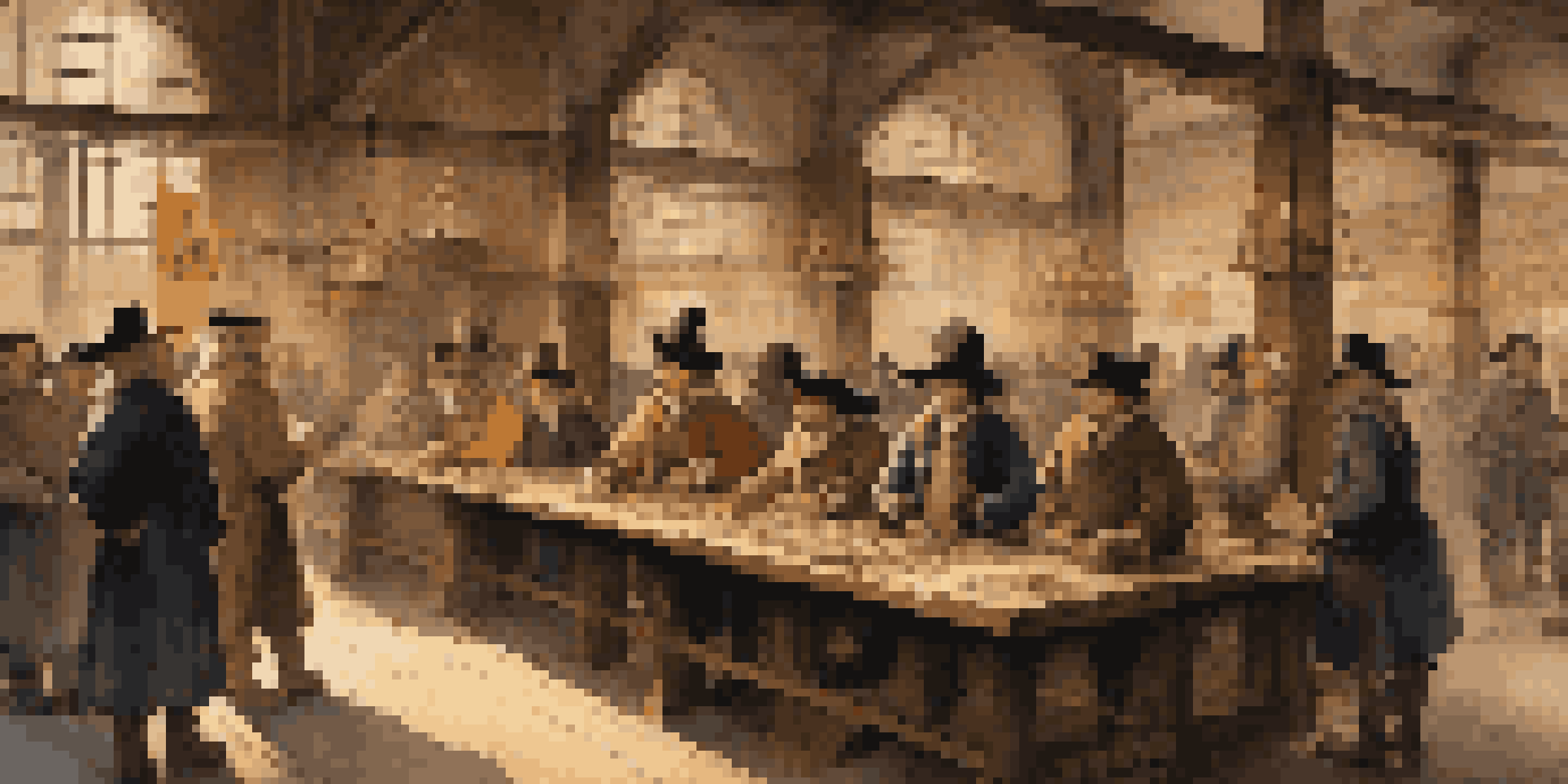The Evolution of Stock Options: A Historical Perspective

The Birth of Stock Options in the 17th Century
Stock options have their roots in the 17th century, particularly in the Amsterdam Stock Exchange, where traders began experimenting with various financial instruments. These early forms of options allowed investors to secure the right to buy or sell shares at a predetermined price in the future. This concept was revolutionary, offering a new way for traders to hedge risks and speculate on price movements.
The stock market is filled with individuals who know the price of everything, but the value of nothing.
As trade became more sophisticated, this early innovation laid the groundwork for what we now know as stock options. The ability to control shares without having to purchase them outright opened doors for increased market participation. It was a turning point that illustrated the potential for financial leverage, making the idea of investing more accessible to a broader audience.
Despite their promising start, stock options remained relatively obscure for several centuries. It wasn't until the modern era of finance that they began to gain widespread recognition and usage, setting the stage for their evolution in the decades to come.
The Rise of Modern Stock Options in the 20th Century
The 20th century marked a significant shift in the landscape of stock options, particularly after World War II. As economies expanded and markets became more dynamic, the need for innovative financial instruments grew. This period saw the introduction of standardized options, which made trading simpler and more transparent for investors.

In 1973, the Chicago Board Options Exchange (CBOE) was founded, becoming the first organized exchange for stock options. This was a game changer, as it provided a structured environment for trading options, increasing liquidity and accessibility. The establishment of standardized contracts meant that investors could trade options with confidence, knowing the terms were clear and consistent.
Origins of Stock Options
Stock options originated in the 17th century, allowing traders to secure rights to buy or sell shares at predetermined prices.
The innovations of this era led to a surge in popularity for options trading. Investors began to recognize the potential for profit, and companies started to offer stock options as part of employee compensation packages, further embedding them in the financial culture.
The Role of Black-Scholes in Valuing Options
In 1973, the introduction of the Black-Scholes model revolutionized the pricing of stock options. Developed by Fischer Black, Myron Scholes, and Robert Merton, this mathematical formula provided a way to calculate the fair value of options based on various factors such as volatility and time to expiration. This was a breakthrough that gave traders a reliable method to assess risk and make informed decisions.
The greatest risk in investing is not the risk of loss, but the risk of missing out on opportunities.
The Black-Scholes model contributed significantly to the growth of the options market by demystifying the valuation process. Investors could now approach options trading with a greater understanding of their potential risks and rewards. This newfound clarity attracted a wider range of participants, from institutional investors to individual traders.
However, it's important to note that while the Black-Scholes model simplified options pricing, it also introduced complexities. For instance, it assumed constant volatility, which isn't always the case in real-world markets. This limitation would lead to further developments in options pricing models, reflecting the dynamic nature of financial markets.
The Tech Boom and Stock Options in the 1990s
The 1990s ushered in a new era for stock options, coinciding with the tech boom and the rise of the internet. As tech companies flourished, many began to offer stock options as part of their compensation packages to attract and retain talent. This trend not only incentivized employees but also aligned their interests with those of shareholders, creating a win-win scenario.
During this time, the appeal of stock options skyrocketed, and they became a staple in the startup ecosystem. Young companies used them as a tool to compete for skilled workers, often offering options as part of their benefits. This helped foster a culture of innovation and entrepreneurial spirit, as employees became more invested in the company's success.
Modernization in the 20th Century
The establishment of the Chicago Board Options Exchange in 1973 marked a significant evolution in the trading of standardized stock options.
However, the dot-com bubble also exposed some underlying issues with stock options, particularly concerning accounting practices. As companies faced scrutiny over their financial reporting, the conversation around stock options evolved, leading to regulatory changes in the early 2000s.
Regulatory Changes and Accounting Standards
In the early 2000s, the rapid growth of stock options and the subsequent burst of the dot-com bubble prompted regulators to reevaluate how these financial instruments were treated. The Financial Accounting Standards Board (FASB) introduced new guidelines requiring companies to expense stock options on their financial statements. This marked a significant shift in how stock options were viewed from an accounting perspective.
The new regulations aimed to improve transparency and provide a clearer picture of a company's financial health. By requiring companies to account for the cost of stock options, investors gained a better understanding of potential dilutions to their shares. This change also encouraged companies to rethink their compensation strategies and seek more sustainable alternatives.
While some argued that this shift would discourage the use of stock options, many organizations adapted by modifying their compensation packages. This led to a more balanced approach to employee incentives, focusing on long-term performance rather than just short-term gains.
The Globalization of Stock Options
As financial markets became increasingly interconnected, stock options began to gain traction beyond the U.S. borders. Countries around the world started adopting options trading, creating a more global market for these instruments. This globalization allowed investors to diversify their portfolios and access new opportunities, further enhancing the appeal of stock options.
International exchanges began to offer their own versions of stock options, leading to the development of unique products tailored to local markets. This trend not only provided investors with more choices but also fostered competition among exchanges, driving innovation in the options space. As a result, traders could benefit from a wider range of strategies and products.
Regulatory Changes Impacting Options
The early 2000s saw new accounting regulations requiring companies to expense stock options, enhancing transparency in financial reporting.
However, this globalization also brought complexities, such as differing regulations and market practices. Investors needed to navigate various legal frameworks and cultural differences, which added layers of complexity to trading. Nevertheless, the expansion of stock options into global markets has contributed to their enduring popularity.
The Future of Stock Options in a Changing Market
Looking ahead, the future of stock options is intertwined with ongoing technological advancements and market dynamics. The rise of algorithmic trading, artificial intelligence, and machine learning is reshaping how options are traded and valued. These innovations are making the market more efficient, but they also raise questions about accessibility for the average investor.
Additionally, the growing emphasis on environmental, social, and governance (ESG) factors is influencing how companies approach stock options. As organizations seek to align their values with their compensation structures, we may see a shift toward more responsible and inclusive options plans. This could benefit not only employees but also shareholders who prioritize sustainable practices.

In conclusion, stock options have come a long way since their inception, adapting to various economic and cultural shifts. As they continue to evolve, understanding their historical context will be crucial for investors looking to navigate the complexities of modern financial markets.